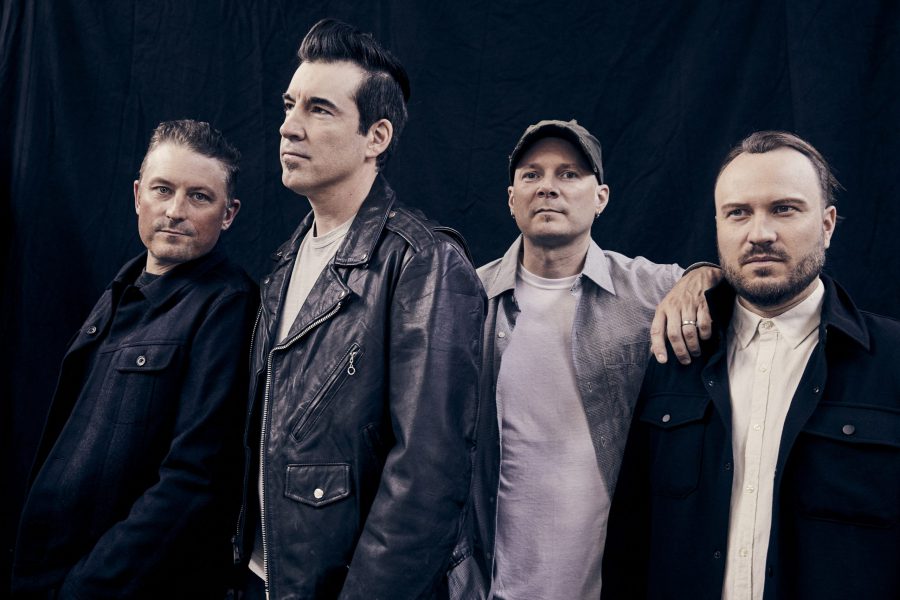INTERVIEW: Theory of a Deadman won’t go the way of the ‘Dinosaur’

Theory of a Deadman, courtesy.
SACRAMENTO — Canadian rockers Theory of a Deadman didn’t exactly play it safe when the band debuted latest single “Dinosaur.”
Skillet, Theory of a Deadman
Saint Asonia
7 p.m., Saturday March 25
Hard Rock Live at Hard Rock Hotel, Wheatland
Tickets: $45-$70.
“Well, you have to play it first somewhere,” guitarist Dave Brenner said. “We just chose to do it in front of I don’t know how many thousands of people.”
Opting not to release the song first, Theory rolled out the bluesy rocker at Aftershock Festival and filmed the performance for a music video.
“That really jacked up the adrenaline,” vocalist and guitarist Tyler Connolly said.
The apocalyptic and socially conscious rocker is the first taste of the band’s as-yet-to-be-named eighth album, the follow-up to 2020’s Say Nothing. Recording once again took the band overseas, this time doing the bulk of the production in Sweden and England. That journey included Atlantis Studios in Stockholm.
“It’s actually the old famous ABBA studio where they recorded all of their massive, smash heavy metal hits,” Connelly said with a keen dry wit.
The choice to travel was a way to distance the band from label reps, management and other outside voices that could clutter the process of writing and recording. Theory of a Deadman was offered a recording facility in New York but passed because it didn’t want to deal with people coming in to check on the band’s progress, Connolly said.
“You want to be able to focus on the at hand,” Brenner added. “If you do it in L.A. or New York, you’re susceptible to the industry; it’s all happening there, so you kinda remove yourself from that.”
That plan turned out to be almost foolproof. While not bothered by the constant presence of industry reps, the band did get a visit from a very resourceful fan after posting a video of the recording process on Instagram. Brenner takes the blame, answering the door to the studio assuming it was a guest of one of the engineers arriving.
“I said, ‘Are you here to see Stefan?’ and she said, ‘No, Theory of a Deadman… you know, Tyler and them?” Brenner said as he lowered his head to recreate the moment. “She came in, we hung out, we chatted for awhile; she was nice.”
Theory’s previous two albums saw the band exploring a wide spectrum of new sounds beyond that of a riff-based rock band. Connolly said the group felt tremendous label support to take risks, especially following the explosion of acoustic-forward “Rx (Medicate),” one of its most successful songs.But more recently, Connolly said the band has been honing in on its core sound.
“To be honest, we did two records—we felt like we had some of the best songs we’ve ever written,” Connolly said. “But this new record really feels like ‘OK, that’s enough.’ I think fans will be really surprised with the sound of our new one.”
As a songwriter, Connolly has developed his own voice and lyrical style, separating himself from his post-grunge contemporaries. The band’s earliest songs were about women, relationships and anger, but the newer material looks at culture, society and politics.
“I love movies, so with the lyrics I want people to actually be able to visualize what I’m talking about,” Connolly said. “On a song like ‘History of Violence,’ you want to actually almost see what the woman looks like that’s being abused.”
Connolly said his writing style has shifted from the metaphorical to the literal, with an added emphasis on storytelling and the occasional witty one-liner mixed in.
“Sometimes it’s way too many lyrics,” he said about his sometimes wordy verses. “I gotta have people sing the words for me because I need to take a breath.”
The new album isn’t the only milestone Theory of a Deadman is celebrating. It’s also marking 20 years since the group’s self-titled debut. Connolly said when he listens back to those songs, he hears an entirely different band, especially the departure from his past deep and husky vocals.
“Honestly, a lot of it is because I was sick for so long,” Connolly said. “We would go and party at the bar until closing at 2 a.m., and then we’d all go back to the studio and keep recording. … That is literally the vocals you hear from these late-late night sessions.”
That first album is reflective of the time, he added, with Brenner adding that it was a learning experience for a band finding its place.
“We just didn’t know. We were so green; we were just a bunch of kids,” Brenner said. “You don’t know what you’re supposed to do.”
Brenner found humor in the transition of the workload from the band’s debut to its sophomore record.
“We got in every day at 10 a.m. and worked until 6 p.m., and then we’ll all head home,” Brenner said. “Oh my God, this is structured.”
Many of the fans who found the band 20 years ago still come to shows and go crazy when those songs are played all this time later. Connolly wouldn’t have it any other way.
“It’s stuck in time. You don’t really want to mess with anything; I’m sure there’s a lot of stuff we could have changed,” Connolly said. “That’s the wonderful thing about making a record. I remember when it came out we were so excited to hear it on the radio; it just works.”
Follow writer Mike DeWald at Twitter.com/mike_dewald.

